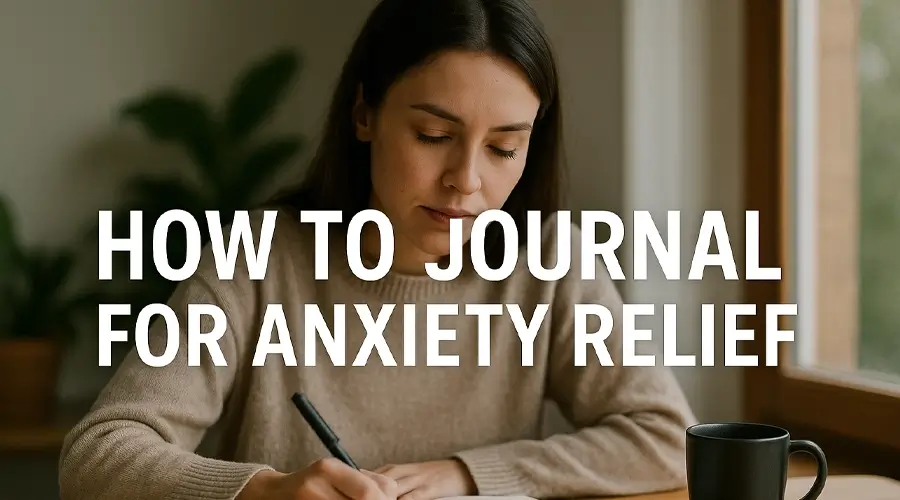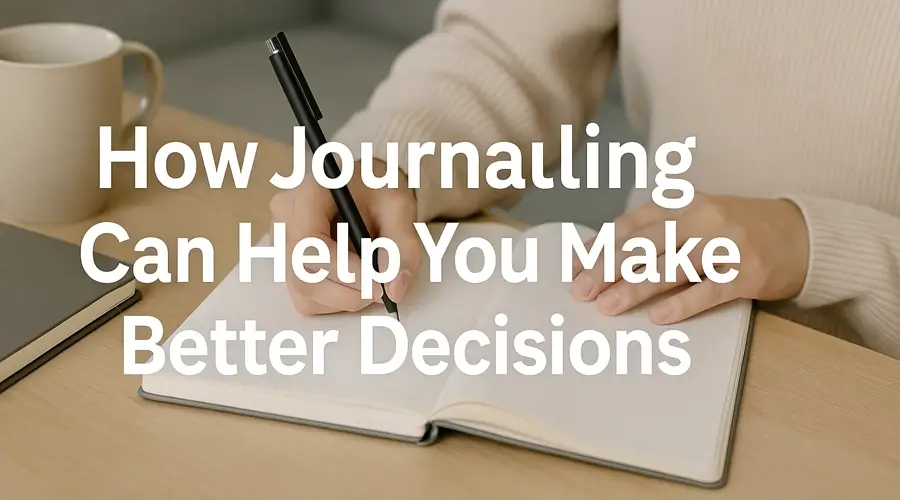You’re scrolling through your phone at midnight—again. Not because there’s something exciting, but because your mind won’t shut up. You’ve had a decent day. Nothing major happened. But there it is: that tightness in your chest, that familiar swirl in your stomach, that nagging voice in your head asking, “Did I forget something? Am I behind? What if tomorrow falls apart?”
Sound familiar?
For most people in their 20s and 30s, anxiety doesn’t always look like a panic attack. It’s subtler, sneakier. It shows up in overthinking every text, in never feeling “caught up,” in waking up tired even after a full night’s sleep. It’s the invisible backpack you carry around every day—filled with unfinished tasks, future fears, and mental noise.
You’ve probably tried all the go-to suggestions. Deep breaths. A walk. A YouTube meditation. And while they help in the moment, they don’t always stick. Because what you’re feeling isn’t just stress—it’s a loop. A pattern. A mental traffic jam with no exit in sight.
That’s where journaling enters—not as a magic fix, but as a flashlight in the fog.
Unlike quick fixes, Anxiety journaling doesn’t just distract your brain. It listens to it. It doesn’t ask you to shut the thoughts down—it gives them a place to live outside your head, safely and judgment-free. And that, right there, is a game-changer.
Because maybe the real relief isn’t in silencing your anxiety—but in understanding it, one word at a time.
Why Anxiety Journaling Works
It’s not just writing. It’s rewiring.
If you’ve ever vented in a long voice message to a friend and felt a little lighter afterward—even if they didn’t respond—you’ve already tasted the magic of externalizing your thoughts.
Anxiety journaling works in a similar way, but deeper. It’s not about beautiful prose or grammar. It’s about turning the chaotic hum of your brain into something tangible. And when you do that, something powerful happens: your mind starts to process instead of panic.

The Psychology of Pen and Mind
Psychologists call it expressive writing. Studies show that when we write about emotionally charged experiences—like anxiety—we activate areas of the brain responsible for emotional regulation, such as the amygdala and prefrontal cortex. In simpler terms: writing helps your brain understand your feelings instead of just feeling them.
It’s the shift from “I’m anxious” to “I notice that I’m anxious because…”
That distance? That’s where the healing begins.
Writing = Slowing Down the Mind
Unlike thinking, writing has a natural speed limit. You can think 60 things per second—but you can only write one sentence at a time. That forced slowness creates clarity. It gives you space to notice the patterns, the triggers, and most importantly: the stories you’re telling yourself.
And sometimes, you’ll catch a thought mid-sentence and go: “Wait, that’s not even true.”
It’s Not Just Expression—It’s Integration
The act of journaling bridges your emotional brain and your logical brain. When you write about your anxiety, you’re not just dumping it—you’re translating it. You’re turning feelings into words, and words into insight.
This is why journaling is more than self-care. It’s self-reconnection.
Of course! Here’s the English version of Section 3 — fully human-written, SEO-friendly, and tailored to the 20–40 audience with a creative, non-generic tone:
Types of Journaling for Anxiety Relief
Not all journaling is created equal — and that’s a good thing.
If you’ve ever stared at a blank page thinking, “What am I even supposed to write?” — welcome to the club. Journaling isn’t a one-size-fits-all solution. Especially when it comes to anxiety, your brain doesn’t always want to cooperate. That’s why it’s helpful to have options.
Here are some powerful styles of anxiety journaling — from messy mind dumps to mindful, creative techniques:
Brain Dump: Clear the Mental Clutter
Think of this as hitting “eject” on your brain.
This technique is simple: write everything. No filter, no formatting, no structure. Just get the chaos out. It could be unfinished to-do lists, fears that don’t make sense, or that annoying comment from earlier today that’s still living rent-free in your head.
Best for: Moments when your brain feels like it’s overheating.
Perks: Pure release. No judgment.
Tip: Even if you write, “I don’t know what to write,” you’re doing it right.
Structured Journaling: Anxiety With a Framework
Sometimes we need more than just expression — we need insight.
Structured journaling gives you a clear path to follow. You reflect intentionally with prompts like:
- What triggered my anxiety today?
- How did I respond?
- What patterns am I noticing?
Best for: Gaining clarity and tracking emotional patterns.
Perks: Makes your anxiety feel less random, more understandable.
Bonus: Try emotion-tracking tables or digital journaling templates.
Prompt-Based Journaling: A Nudge When You Need It
When you want to write but don’t know where to begin, journal prompts are your best friend.
They’re like tiny keys that unlock bigger thoughts:
- “What’s one thing I’m avoiding today?”
- “What do I wish someone would say to me right now?”
- “If my anxiety had a voice, what would it say — and how would I respond?”
Best for: When you’re stuck or tired of repeating the same thoughts.
Perks: Helps you uncover new emotional layers.
Tools: Prompt-filled journals or journaling apps with daily questions.
Free Writing: Let Your Mind Wander
This one’s raw, real, and wonderfully unstructured. Set a timer (5–10 minutes) and just write. Don’t edit, don’t pause. Let your thoughts flow like a stream of consciousness.
Best for: Building emotional momentum.
Perks: You often uncover surprising thoughts mid-sentence.
Reminder: Typos are welcome. This isn’t for anyone but you.
Future Self Letters: Speak From Strength
Write a letter to your future self — the version of you who’s already handled this tough moment. Or flip it: write as your future self, sending wisdom back in time.
“You’re doing better than you think.”
“This version of you is temporary. Growth is happening underneath.”
Best for: Moments of doubt, burnout, or when you’re losing perspective.
Perks: Builds internal trust and self-reassurance.
What-If Flips: Rewrite the Narrative
An anxious brain loves worst-case scenarios. So let’s flip them.
Take every “What if I mess this up?” and write a counter-narrative:
“What if I handle it better than I expect?”
“What if I’m actually more capable than I think?”
It sounds simple, but it rewires the way you process uncertainty. Over time, these flipped thoughts start to stick.
Best for: Interrupting negative spirals.
Perks: Builds mental flexibility and hope.
At the end of the day, there’s no “right” way to journal — only the way that feels right to you. Your method might change based on your mood, energy, or anxiety level. And that’s perfectly okay.
What matters is this: you’re showing up, you’re putting thoughts to paper, and you’re choosing to meet your anxiety with curiosity — not fear.
How to Start a Journaling Habit (Without Forcing It)
Because if it feels like a chore, you won’t come back to it.
Let’s be honest — journaling sounds simple in theory, but building it into a daily rhythm? Not always easy. Especially when your schedule is a mosaic of meetings, scrolling, overthinking, and trying to just keep up.
The good news is: anxiety journaling doesn’t have to be perfect. Or long. Or daily.
It just has to be yours.

Here’s how to make it feel like a grounding habit — not another task on your to-do list:
Design Your Writing Space (Or Don’t)
You don’t need an aesthetic desk with sunlight filtering through vintage curtains.
But you do need a spot that feels like your zone — calm, undistracted, and safe.
It can be:
- Your bed before sleep
- A coffee shop with headphones
- That corner of the kitchen table that somehow feels cozier at night
The goal isn’t a Pinterest-perfect space. It’s emotional permission.
Pro tip: Keep your journal (or phone/app) within easy reach. If it’s out of sight, it’s usually out of mind.
Choose a Time That Matches Your Mindset
Some people journal first thing in the morning to clear the fog. Others do it at night to unpack the day.
There’s no right answer — only the rhythm that works for you.
Ask yourself:
- When is my anxiety the loudest?
- When do I have 5–10 minutes just for myself?
Start with less. Even 3 minutes of writing is powerful. You’re not building a habit — you’re building consistency. The difference matters.
Tiny Tricks to Keep Going
- Anchor it to another habit. Write after brushing your teeth, or before you check social media.
- Use “one-line journaling.” If you can write a single sentence, you can journal.
- Make it emotionally rewarding. Light a candle, play music, or grab your comfort drink.
- Re-read old entries once a week. It reminds you how far you’ve come (and shows you your growth is real).
- No rules = more freedom. Don’t force yourself to write every day. Let the habit come to you.
In the end, starting a journaling habit is like starting a conversation with yourself. One that’s messy, honest, and healing.
You don’t need pressure — you need presence.
And once you start showing up for yourself, the habit stops being a task — and becomes a home.
What to Write When Your Mind Feels Like Static
Because even noise deserves a voice.
There are two kinds of journaling blocks:
- Your brain feels like a blank wall.
- Your brain feels like a swarm of bees.
And ironically, both are rooted in anxiety.
Too many thoughts = overwhelmed.
No thoughts = shut down.
In either case, it’s easy to tell yourself, “There’s nothing worth writing,” or worse, “This won’t help anyway.”
But that’s exactly when journaling becomes most powerful — not because you’ll write something profound, but because you’re giving your chaos a container.
So… what do you write?
Start With the Obvious (Even If It Feels Pointless)
Literally write:
- “I don’t know what to write right now.”
- “My brain feels scrambled and heavy.”
- “Everything feels too much, and I don’t know why.”
This may sound silly, but it gives your mind permission to show up as it is — not how it “should” be.
Use Anchoring Prompts for Messy Minds
Prompts are gentle guides when you can’t find your own words. Especially in anxious moments, they help steer the emotional storm into something writable.
Here are some real-world prompts for different anxiety moods:
When You Feel Overwhelmed:
- “What’s making me feel unsafe or uncertain right now?”
- “What would I say to a friend who felt like this?”
- “If I could press pause on one thing today, what would it be?”
When You Feel Numb or Disconnected:
- “If I had to describe today in one color, what would it be — and why?”
- “What did I not allow myself to feel this week?”
- “If I could whisper one truth to myself, without fear, it would be…”
When Your Thoughts Are Spiraling:
- “What’s the worst-case scenario I’m imagining — and how likely is it, really?”
- “What is one thing I can control right now?”
- “What story am I telling myself that might not be true?”
When You’re Tired of Your Own Mind:
- “What am I sick of thinking about?”
- “What’s one tiny act of peace I can give myself today?”
- “If my anxiety had a name and personality, what would it say? What would I say back?”
Bonus Techniques for Foggy Brains:
- 5 Things: Write down 5 things you see, hear, feel, want, or need.
- The “Worry Dump”: List every anxious thought — even the irrational ones. Then rate how likely each one is from 1 to 10.
- Gratitude with a twist: Instead of “what am I grateful for?”, try: “What didn’t go wrong today?”
Journaling in static moments isn’t about clarity — it’s about courage.
You’re not writing because you know what to say.
You’re writing because you don’t, and that’s where healing begins.
How to Not Judge What You Write
Your journal is not a performance. It’s a relationship.
Let’s get one thing clear:
Journaling is not Instagram.
It’s not for likes.
It’s not for your future memoir.
It’s for you — messy, tired, beautiful, anxious you.
And yet… we judge.
We look back at what we wrote and think:
“This sounds stupid.”
“I’m being dramatic.”
“Why do I always write the same thing?”
But here’s the truth: judging your journal is like yelling at your inner child for crying.
You don’t need better words. You need a softer lens.
Silence the Inner Critic
The voice in your head that says, “You’re not doing this right” is not your truth.
It’s programming. School essays. Social comparison. Perfectionism dressed as productivity.
But your journal is the one space where none of that matters.
It doesn’t have to sound smart. Or make sense. Or even finish the sentence.
Your only job? Be honest. Be present. Be kind.

Why “Good Writing” Is the Wrong Goal
Forget grammar. Forget structure. Forget trying to “write well.”
This isn’t storytelling. It’s soul-telling.
In fact, the uglier the writing, the more healing it might be.
Because that means you’re not filtering. You’re not editing your pain into something pretty.
You’re letting it live — raw, real, and fully felt.
Try this mindset shift:
- Instead of: “What should I write?”
- Ask: “What needs to be said?”
Practicing Self-Compassion Through Journaling
Most people use journals to track their flaws.
But you? You can use yours to rewrite your tone — the way you speak to yourself.
Here’s how to practice self-compassion journaling:
Write to yourself like a friend.
If you wouldn’t say it to someone you love, don’t write it to yourself.
Use affirming language, even when you’re low.
“I’m having a hard time, and that’s okay.”
“I don’t feel strong today, but I showed up.”
“I’m learning to sit with discomfort — and that’s brave.”
Celebrate the small stuff.
Not every entry has to solve something. Sometimes just writing “I survived today” is enough.
And honestly? That’s a victory.
Your journal is not a place to prove yourself — it’s a place to meet yourself.
Let it be imperfect. Let it be repetitive. Let it be wildly unfiltered.
Because in a world where we’re constantly asked to perform, your journal is your one space to just be.
conclusion
Journaling for anxiety relief isn’t about being a great writer — it’s about being radically honest with yourself. It gives your swirling thoughts a place to land, your hidden fears a voice, and your anxious patterns a mirror. Whether you’re free-writing, responding to prompts, or scribbling messy brain dumps, the goal isn’t clarity — it’s connection. You don’t need a perfect routine, a fancy notebook, or deep thoughts. You just need a moment of presence, a bit of kindness toward yourself, and the courage to let what’s inside come out. Over time, this simple act becomes a habit, a safe space, and maybe even a quiet revolution in how you treat your mind.
Discover your inner world with VERBOAI.
Let AI be your companion on the journey of writing.



